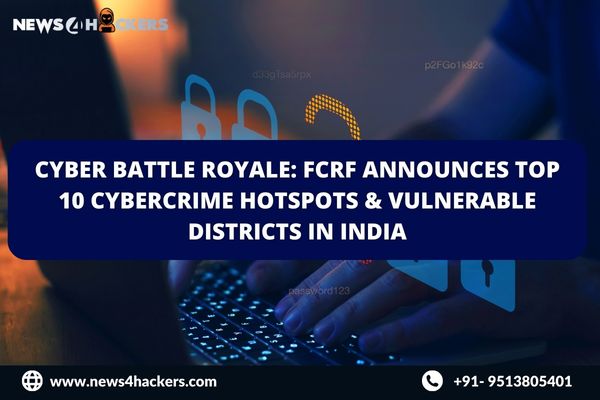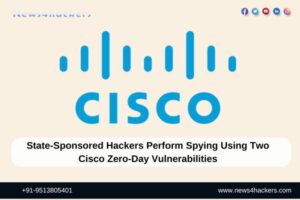Cyber Battle Royale: FCRF Announces Top 10 Cybercrime Hotspots & Vulnerable Districts in India

New Delhi: India is currently confronted with a significant and escalating challenge in the form of cybercrime. A remarkable 80 percent of reported cybercrime incidents originate from a mere ten susceptible districts, as elucidated in a recent white paper entitled “A Deep Dive into Cybercrime Trends Impacting India,” authored by the Future Crime Research Foundation (FCRF), a non-profit organization that has been nurtured at IIT Kanpur. The survey underlines the urgent need for stronger cybersecurity measures and increased awareness among both individuals and enterprises.
Announcing the Top 10 Cybercrime Epicenters
This investigation illuminates the 10 districts in India that exhibit the most susceptibility to cybercrime, offering valuable insights into the underlying variables that contribute to their vulnerability. It is imperative to consider these factors in order to develop efficacious measures for prevention and mitigation.
1. Bharatpur (18%)
The high incidence of cybercrime in Bharatpur can be linked to its geographical proximity to large urban centers such as Delhi and Jaipur, which potentially facilitates the establishment of a hub for cybercriminal activity. The population’s susceptibility is further exacerbated by a lack of knowledge and computer literacy.
2. Mathura (12%)
The elevated incidence of cybercrime in Mathura can be attributed to its recognition as a famous tourist destination, resulting in a substantial influx of financial transactions and rendering it an appealing target for cybercriminals. The problem is exacerbated by the presence of inadequate cybersecurity infrastructure and a lack of awareness among both enterprises and individuals.
3. Nuh (11%)
The heightened incidence of cybercrime in Nuh can be attributed to its geographical proximity to the National Capital Region (NCR), which serves as a magnet for both cyber criminals and potential victims. The presence of socio-economic issues in the region further exacerbates the issue, leading to the utilization of cybercrime as an unlawful means of generating revenue.
4. Deoghar (10%)
The cybercrime rate in Deoghar is influenced by the inadequacy of law enforcement resources and the absence of dedicated cybercrime units. The local populace’s restricted digital literacy and awareness render them more vulnerable to internet fraudulent activities.
5. Jamtara (9.6%)
Jamtara has gained notoriety as a prominent center for cybercriminal operations, specifically in the realm of online fraud and phishing. The region accommodates efficiently structured criminal networks, cultivating an environment conducive to the proliferation of cybercriminal activities.
6. Gurgaon (8.1%)
The elevated incidence of cybercrime in Gurgaon can be attributed to its prominent position as a significant business and IT center, which attracts hackers with the intention of acquiring important data or financial benefits. Despite the presence of economic prosperity, there continue to be persistent discrepancies in digital literacy and cybersecurity awareness across the diverse community.
7.Alwar (5.1%)
The relatively low incidence of cybercrime in Alwar can be linked to its strategic geographical position between Delhi and Rajasthan, which renders it a potential hub for cybercriminal activities. The presence of inadequate cybersecurity infrastructure and a lack of understanding of cybersecurity in smaller towns within the district exacerbate the vulnerability.
8. Bokaro (2.4%)
The cybercrime rate in Bokaro is attributed to the absence of dedicated cybercrime units and inadequate resources for law enforcement agencies. The presence of economic issues within the region compels individuals to turn to cybercrime as an alternate means of generating income.
9. Karma Tand (2.4%)
The cybercrime rate in Karma Tand is subject to impact from neighboring districts characterized by greater cybercrime rates, hence enabling the proliferation of cybercriminal operations. The population’s vulnerability to online fraud is heightened due to the restricted availability of digital education and cybersecurity resources.
10. Giridih (2.3%)
The cybercrime rate in Giridih is associated with its geographically isolated position and inadequate law enforcement resources, rendering it an appealing hub for cybercriminal activities. The local population’s susceptibility is exacerbated by a dearth of digital literacy and awareness.
Understanding the Types of Cybercrimes Prevalent in Specific Regions
Different forms of cybercrimes are widespread in particular geographical areas, underscoring the necessity for focused approaches and awareness initiatives to effectively address these risks.
| State/ Union Territory | Types of Cyber Crimes |
| Rajasthan | Instances of cybercrime such as sextortion, OLX fraud, customer care fraud, OTP scams, KYC fraud, electricity bill fraud, and KBC scams have been observed. |
| Jharkhand | Instances of Harassment in Loan Applications, Fraudulent Activities in Gift Transactions, Deceptive Practices in Matrimonial Engagements, Fraudulent Activities in Electricity Bill Payments, and Deceptive Practices in Job and Investment Opportunities. |
| Delhi | Fake Links, OTP Frauds, Social Engineering Scams, Debit/Credit Card Frauds |
| Bihar | Fake Links, OTP Frauds, Social Engineering Scams, Debit/Credit Card Frauds |
Emerging Cybercrime Hotspots Require Proactive Actions
As the landscape of cybercrime hubs continues to develop, the emergence of new hotspots underscores the need for proactive measures to effectively mitigate diverse forms of digital criminal activity. The following locations in India have been identified as growing hotspots for cybercrime:
| State/ Union Territory | Emerging Cyber Crime Hotspots |
| Andhra Pradesh | Chittoor |
| Assam | Barpeta, Dhubri, Golpara, Morigaon, Nagaon |
| Bihar | Banka, Begusarai, Jamui, Nalanda, Patna, Sasaram, Sheikhpura |
| Delhi | Ashok Nagar, Uttam Nagar (West), New Ashok Nagar, ShakkurPur (East), Harkesh Nagar Okhla (South East), DasrathPuri, RK Puram (South West), Azadpur (North West) |
| Gujarat | Ahmedabad, Surat |
| Haryana | Bhiwani, Nuh, Hatangoan, Manota, Hasanpur, Palwal |
| Jharkhand | Latehar, Dhanbad, SanthalPargana, Hazaribagh, Khunti, Narayanpur, Ranchi |
| Karnataka | Bengaluru |
| Madhya Pradesh | Guna |
| Maharashtra | Aurangabad, Mumbai |
| Odisha | Balasore, Dhenkanal, Jajapur, Kendujhar, Mayurbhanj |
| Punjab | Fazika, Mohali |
| Rajasthan | Bidarka, Alwar, Barmer, Bharatpur, Dungarpur, Jaipur |
| Tamil Nadu | Chennai, Coimbatore |
| Telangana | Hyderabad, Mahbubnagar |
| Tripura | Dhalai |
| Uttar Pradesh | Bulandshahar, Ghaziabad, Jhansi, Kanpur, Lucknow, DomakhasMaharajganj, Mathura, Sitapur, Mathura, Jevar, GautamBudh Nagar |
| West Bengal | PurbaBardhaman, Dhulchandria, Bhadral, DakshinDinajpur, Birbhum, PaschimBardhaman, Burnpur, Barchaman, Howrah, Kolkata, Malda, Baharampur, Nadia, NekraMahuli (Paschim) |
The aforementioned rising hotspots necessitate aggressive steps to effectively address diverse manifestations of digital criminal activity and establish a more secure cyber environment.
Unraveling the Surge in Cyber Crime: Key Factors
The increase in cybercrime occurrences can be ascribed to a multitude of variables that have fostered a favorable climate for illicit operations.
- Low Skills Required
- The reduction of technological obstacles facilitates the participation of persons with less competence in cybercriminal operations through the utilization of easily accessible hacking tools and malware.
- Poor KYC and Verification
- Insufficient implementation of Know Your Customer (KYC) protocols and verification procedures on digital platforms facilitates the creation of fraudulent identities by criminals, hence posing significant difficulties for law enforcement agencies in their efforts to track and apprehend these individuals.
- Availability of Fake Resources
- The availability of counterfeit accounts and leased SIM cards in illicit markets facilitate the anonymous operations of cyber criminals, hence posing challenges to the tracking and prosecution of these individuals.
- Affordable AI Tools
- The accessibility of AI-powered cyberattack technologies enables malevolent actors to automate and expand their attacks, hence enhancing their efficacy.
- Accessible VPNs
- Virtual private networks (VPNs) offer a means for cybercriminals to maintain anonymity, so impeding the efforts of law enforcement agencies to track their online activities and ascertain their geographical whereabouts.
- Recruitment and Training
- Cybercrime syndicates actively recruit and provide training to persons who are either unemployed or underemployed, hence contributing to the expansion of a burgeoning population of prospective criminals.
Combating the Escalating Threat of Cybercrime
The mitigation of the increasing prevalence of cybercrime necessitates the implementation of a comprehensive strategy that bolsters cybersecurity protocols, augments law enforcement capacities, and fosters the development of digital literacy. Efficient approaches ought to prioritize education, awareness, and collaboration as means to establish a more secure digital environment for all individuals.
About The Author:
Yogesh Naager is a content marketer who specializes in the cybersecurity and B2B space. Besides writing for the News4Hackers blog, he’s also written for brands including CollegeDunia, Utsav Fashion, and NASSCOM. Naager entered the field of content in an unusual way. He began his career as an insurance sales executive, where he developed an interest in simplifying difficult concepts. He also combines this interest with a love of narrative, which makes him a good writer in the cybersecurity field. In the bottom line, he frequently writes for Craw Security.
Rad More Article Here:






